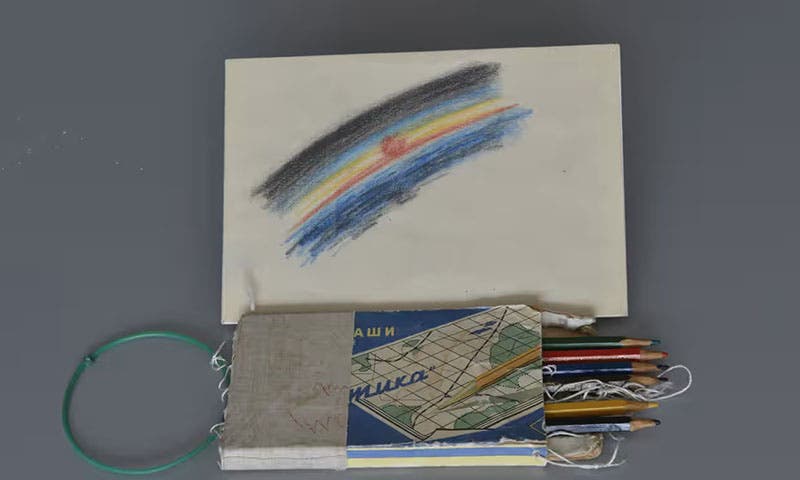Scientist of the Day - Alexei Leonov
Alexei Leonov, a Soviet and Russian cosmonaut, was born May 30, 1934, in Siberia. He was raised in Kaliningrad and attended art school in Riga, before deciding to become a pilot, enrolling in flight school in the Ukraine. After a short stint as a lieutenant in the Air Army, he was selected in 1960, along with 19 others (including Yuri Gagarin), to the first contingent of Soviet cosmonauts. He would spend his life in the Soviet space program and become its Chief Cosmonaut and one of its great ambassadors, even in countries like England and the United States.
The feat that brought him to world-wide public attention was his spacewalk in 1965, as part of the Voskhod 2 mission to orbit the Earth. Voskhod 2 had two men crammed into a small capsule, and an inflatable airlock (second image). On Mar. 18, 1965, Leonov inflated the airlock, donned a space suit, attached his tether, and put a camera in place to record his activities at the end of his 50-foot tether. Unfortunately, his spacesuit ballooned in the vacuum of space, so that he could not reach his own camera, and when he tried to re-enter the airlock, he found his bloated suit was too large for reentry. He had to bleed out a great deal of air (thereby risking the bends) before he could squeeze back in. He had spent 12 minutes in space. Voskhod 2 experienced further difficulties on reentry and landed in a deep forest in the Urals, almost 300 miles off target, and the two cosmonauts spent two nights among the bears and wolves until rescuers could get to them on skis, and get them out the same way. It was amazing that Leonov survived. But he was a pretty amazing fellow.
Leonov’s spacewalk was a first. The United States would not attempt a spacewalk until three months later, when Ed White drifted at the end of his tether for 21 minutes as part of Gemini IV. You can see 60 seconds of Leonov’s spacewalk, in color, on a YouTube video. The walk was shown, at least initially, on live television, but the broadcast was terminated when things started to go south.

“Sunrise” sketched by Alexei Leonov on the Voskhod 2 mission, Mar. 18, 1965, the first work of art made in space, Museum of the Yuri Gagarin Cosmonaut Training Center, Moscow Oblast, Russia, exhibited, with the original pencils used by Leonov, at the Science Museum, London, 2015-16 (theguardian.com)
The ready back-up spacecraft for the Voskhod 2 mission is on display at the Cosmosphere in Hutchinson, Kanss, with the airlock inflated and a Leonov decoy emerging from the hatch. One of the Cosmosphere curators made a short video in front of the display that is well worth watching.
Leonov was scheduled for many other Soviet space flights, including the first Soviet landing on the Moon, but the Soviet space program did not do well after the death of its mastermind, Sergei Korolev, in 1966, and none of these missions ever came to pass. But Leonov did get a second great moment in space when, in 1975, he commanded the Soyuz half of the Apollo-Soyuz mission, where Soviet and American spacecraft docked in orbit, and Korolev shook hands with American Thomas P. Stafford through an opened hatch. Stafford and Leonov formed a bond of friendship that continued long after both retired from active space duty. The photo of the crew – two Russians and three Americans (third image) – is interesting because the Russians have their mission patches oriented so that they read "Soyuz-Apollo", while the American patches read "Apollo-Soyuz” – the two nations referred to the mission by the two different names, each putting their own countries first. It was clever of someone to think of a way for one patch to tell two different stories.
And we should certainly note that Leonov was the first ever on-board space artist. He had always been interested in painting and had taken art lessons off and on for years. When he was sent up in Voskhod 2, he arranged to bring his pencils along (strung together so he could keep track of them in the weightless cabin) and he made a pencil sketch of a sunrise from space, while on the Voskhod (Voskhod means “sunrise” in Russian). The painting (and the pencils) survived (fourth image), preserved in the Museum of the Yuri Gagarin Cosmonaut Training Centre in Moscow (which Leonov directed for many years), and they were loaned to the Science Museum, London, in 2015 for an exhibition: "Cosmonauts: Birth of the Space Age.” When Leonov was in London for the exhibition opening, he talked with and made a sketch of Stephen Hawking, which he presented to Hawking as part of his talk. Both men seem to have been greatly impressed with each other.
Leonov has left us some 200 space-themed paintings, nearly all made back on Earth, including one, painted in 1973, of his spacewalk of 1965 (fifth image; this painting was also loaned to the Science Museum for their exhibition). A photo of Leonov, at work on one of his paintings, portrays him, one might guess, about 1976 (sixth image).
Leonov died on Oct. 11, 2019, at the age of 85. A funerary tribute was delivered in Moscow, and in Russian, by Thomas P. Stafford.
William B. Ashworth, Jr., Consultant for the History of Science, Linda Hall Library and Associate Professor emeritus, Department of History, University of Missouri-Kansas City. Comments or corrections are welcome; please direct to ashworthw@umkc.edu.










![Using an astrolabe to measure the depth of a well, woodcut in Elucidatio fabricae vsusq[ue] astrolabii, by Johannes Stöffler, 1513 (Linda Hall Library)](https://assets-us-01.kc-usercontent.com:443/9dd25524-761a-000d-d79f-86a5086d4774/a998eb50-55d2-4a88-ace2-a50aa5fa86e7/Stoffler%201.jpg?w=210&h=210&auto=format&fit=crop)

